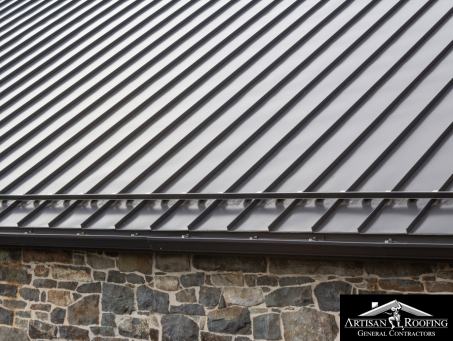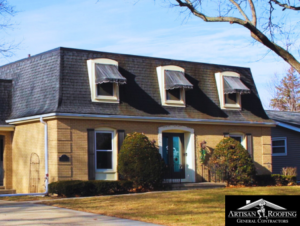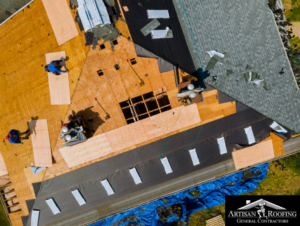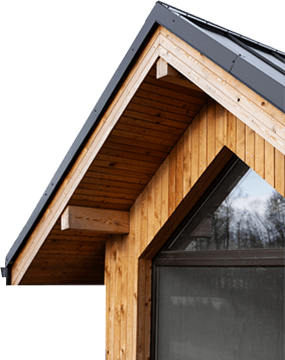If you’re looking for a roofing solution that combines durability, energy efficiency, and modern aesthetics, a standing seam metal roof is an exceptional choice. Known for its sleek design, resilience against harsh weather, and potential to save on energy bills, this type of roofing system has become increasingly popular among homeowners and builders alike. Not only does a standing seam metal roof offer an impressive lifespan, but it also requires less maintenance than many traditional roofing options, making it an attractive long-term investment.
In this comprehensive guide, we’ll explore all aspects of standing seam metal roofs, including the materials used, installation process, benefits, and maintenance tips. By the end, you’ll have a solid understanding of whether a standing seam metal roof is the best option for your home.
What Is a Standing Seam Metal Roof?
A standing seam metal roof is defined by its vertical panels with raised seams, known as “standing seams,” which run continuously from the roof’s ridge to the eave. These raised seams interlock, providing a watertight barrier against water infiltration. Unlike traditional roofing materials that rely on visible nails or screws, standing seam metal roofs are installed using clips and hidden fasteners, creating a clean, modern appearance while enhancing the roof’s durability.
The design and installation method of standing seam metal roofs makes them highly resistant to extreme weather conditions, including heavy snow, high winds, and intense sunlight. This type of roofing system is suitable for a wide range of architectural styles, from contemporary designs to classic homes, and its longevity can make it a cost-effective choice over time.
Components of a Standing Seam Metal Roof
A standing seam metal roof comprises several critical elements, each contributing to its strength, durability, and functionality. Here are the key components involved in a complete standing seam metal roofing system:
- Roof Decking
Roof decking serves as the foundation for any roofing system. It is typically made from materials like plywood, OSB (oriented strand board), or plank and provides a solid surface for attaching other roofing components. Before installing a standing seam metal roof, the roof decking should be inspected for any signs of rot, damage, or instability, as these issues can compromise the integrity of the entire roof. - Lock Strip
Lock strips secure the edges of the metal panels at the eaves and rakes (the sloped edges of the roof). These strips prevent the panels from lifting in high winds and ensure a secure attachment. Lock strips are usually made from the same material as the standing seam panels, providing both visual consistency and enhanced durability. - High-Heat Ice and Water Shield Underlayment
Underlayment is a protective layer installed between the roof decking and the metal panels. For metal roofs, a high-heat ice and water shield is recommended to withstand temperature fluctuations that cause expansion and contraction. This underlayment helps protect the decking from moisture, preventing water damage and enhancing the roof’s overall durability. - Standing Seam Metal Panels
The metal panels are the visible part of the roof and cover the majority of the roofing area. Made from materials such as steel, aluminum, or copper, these panels come with a protective coating to prevent corrosion. The panels are attached to the roof using hidden clips and interlock along the seams, creating a seamless and watertight surface. - Clips
Clips are fasteners that secure the metal panels to the roof deck. They allow for thermal movement (expansion and contraction) of the metal, preventing buckling or warping over time. Properly placed clips contribute to the stability and longevity of the roofing system. - Z Bar
A Z bar is a piece of metal flashing installed at critical junctions, such as where the metal panels meet the ridge capping. It fills gaps between the ribs of the panels, providing additional protection against water infiltration. - Ridge Capping and Transition Metal
Ridge capping covers the roof ridge, where two slopes meet, while transition metal is used where the roof transitions from a low slope to a steeper slope. These components are crucial for preventing leaks and ensuring a uniform appearance.
The Installation Process for Standing Seam Metal Roofs
The installation of a standing seam metal roof is a precise and specialized process. Here’s a step-by-step look at how it’s done:
- Inspection and Preparation
Before installation, a thorough inspection of the existing roof and roof decking is conducted. Damaged or rotting decking is replaced, and the installation area is cleared of debris. A solid foundation is essential for the long-term performance of a standing seam metal roof. - Installing the Underlayment
A high-heat ice and water shield is laid over the roof decking to protect against water infiltration and provide a barrier between the decking and metal panels. - Attaching Lock Strips
Lock strips are installed along the eaves and rakes to hold the edges of the metal panels securely. These strips prevent the edges from lifting in high winds. - Securing the Metal Panels
Metal panels are attached using clips that fasten to the roof deck. Each panel interlocks with the next at the vertical seams, creating a continuous, weather-tight surface. - Installing the Z Bar and Ridge Capping
Once the panels are in place, the Z bar is installed to fill any gaps, and ridge capping is attached to cover the roof’s ridge, ensuring a secure and watertight seal. - Final Inspection and Clean-Up
After installation, a final inspection checks that all components are correctly installed and the roof is free of potential issues. The work area is then cleaned, and any debris is removed.
Advantages of a Standing Seam Metal Roof
Opting for a standing seam metal roof comes with a variety of benefits that make it a worthwhile investment:
- Exceptional Durability
Standing seam metal roofs, if maintained properly, can last for over 5 decades, outlasting traditional materials like asphalt shingles, which typically last 20–30 years. This makes them an ideal choice for homeowners seeking a long-term roofing solution. - Energy Efficiency
Metal roofs reflect a substantial portion of the sun’s heat, helping to keep your home cooler during hot months. Many metal roofs are designed with reflective coatings, which can further improve energy efficiency and lower cooling costs. - Superior Weather Resistance
Metal roofs are highly resistant to adverse weather, including high winds, heavy rain, hail, and snow. The interlocking seams and concealed fasteners prevent water from penetrating the roof, reducing the likelihood of leaks. - Low Maintenance Requirements
With hidden fasteners and durable materials, standing seam metal roofs require minimal maintenance. Periodic inspections and occasional cleaning are typically sufficient to keep the roof in optimal condition. - Enhanced Aesthetic Appeal
Standing seam metal roofs provide clean, modern lines that enhance curb appeal. They come in different colors and finishes. This allows homeowners to customize their roof’s aesthetic to match their home’s style. - Environmental Benefits
Did you know that metal roofing materials are sometimes produced from recycled materials? In addition, they are also fully recyclable which means less waste and resources. This makes standing seam metal roofing an eco-friendly option for homeowners.
Choosing the Right Material for a Standing Seam Metal Roof
Standing seam metal roofs can be crafted from different materials, each offering distinct characteristics. Here’s an overview of popular materials:
- Steel. Known for its strength and affordability, steel is often coated with finishes to prevent rust. It’s an excellent choice for those seeking durability without a premium price tag.
- Aluminum. Corrosion-resistant and lightweight, aluminum is ideal for coastal or humid regions. Although slightly more expensive than steel, it provides excellent longevity.
- Copper. A high-end option, copper has a unique look and develops a beautiful patina over time. However, copper roofs are among the most expensive choices.
- Zinc. Environmentally friendly and low-maintenance, zinc develops a protective patina and offers exceptional durability. Zinc roofs are highly resistant to corrosion and can last even longer than other metals.
Is a Standing Seam Metal Roof Right for Your Home?
When deciding if a standing seam metal roof is suitable for your home, consider these factors:
- Cost. Standing seam metal roofs have a higher upfront cost than traditional materials. However, their durability and low maintenance requirements often make them cost-effective in the long term.
- Climate. Metal roofs perform well in extreme climates, including regions with heavy snowfall, high winds, or hot temperatures. They’re also fire-resistant, a significant benefit in areas prone to wildfires.
- Aesthetic Preference. If you’re looking to enhance your home’s appearance, a standing seam metal roof offers a sleek, contemporary look that complements many architectural styles.
- Longevity. Homeowners planning to stay in their homes for a long time can benefit from the extended lifespan of a metal roof, often lasting 50 years or more.
- Environmental Impact. With recyclable materials and high energy efficiency, standing seam metal roofs are an environmentally responsible choice.
Maintenance Tips for Standing Seam Metal Roofs
Although standing seam metal roofs are low-maintenance, regular care can help maximize their lifespan:
- Annual Inspections. Check for any signs of damage, loose panels, or rust spots at least once a year.
- Clean Off Debris. Remove leaves, branches, and other debris that may accumulate in seams and valleys, especially after storms.
- Keep Gutters Clear. Ensure gutters are free of debris to prevent water backup and potential roof damage.
- Monitor for Rust. Look for any signs of rust, particularly in areas where the protective coating may have worn away.
- Trim Overhanging Branches. Keep trees trimmed to prevent branches from scraping the roof surface.
- Monitor Snow Accumulation. In colder climates, remove heavy snow buildup to prevent ice dams and excess weight.
Comparing Standing Seam Metal Roofs to Other Roofing Options
When considering a standing seam metal roof, it helps to compare it to other common materials:
- Asphalt Shingles. Affordable but short-lived and susceptible to damage. They require more frequent maintenance and replacements.
- Clay and Concrete Tiles. Durable and visually appealing but heavy and prone to cracking under impact.
- Wood Shakes and Shingles. Attractive but high-maintenance and vulnerable to fire, mold, and pests.
- Slate Roofing. Extremely durable and long-lasting but heavy and costly.
Making the Decision: Is a Standing Seam Metal Roof Right for You?
A standing seam metal roof is a long-term investment offering exceptional durability, energy savings, and aesthetic appeal. While the upfront cost may be higher than other materials, the low maintenance, extended lifespan, and energy efficiency make it a worthwhile choice. By understanding the installation, materials, and benefits, you can make an informed decision that suits your needs.
If you’re ready to explore standing seam metal roofing, contact Artisan today. Our expert team is here to provide guidance, answer your questions, and deliver a custom solution tailored to your home’s unique requirements.






